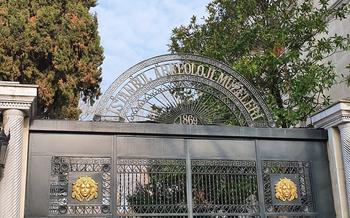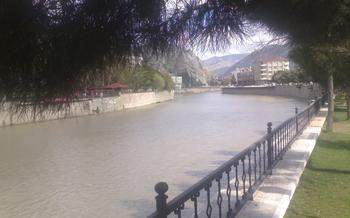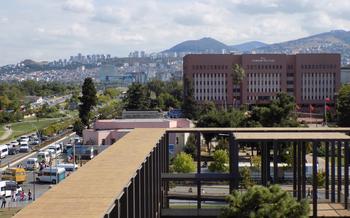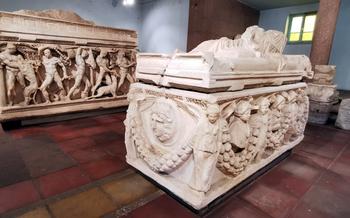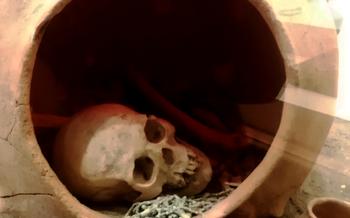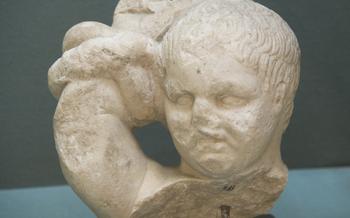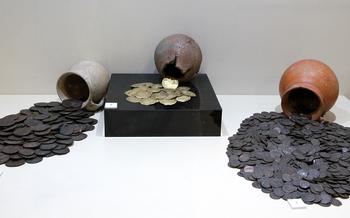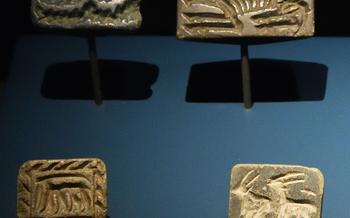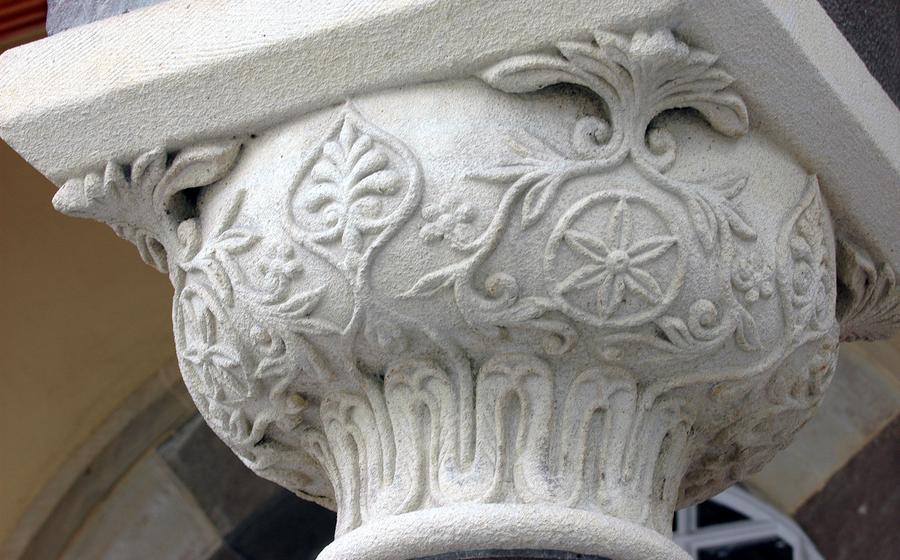
Kastamonu Museum of Archaeology
- Kastamonu Museum of Archaeology: A Historical Haven
- Navigating the Museum's Exhibits: A Journey Through Time
- Unearthing Kastamonu's Ancient Civilizations
- Islamic Art and Architecture: A Testament to Cultural Fusion
- Ethnographic Treasures: A Glimpse into Local Traditions
- Interactive Learning Experiences: Engaging All Senses
- Exploring the Museum's Special Collections
- Unveiling the Stories Behind the Artifacts
- Inspiring Creativity and Artistic Expression
- Preserving Kastamonu's Cultural Heritage: A Community Effort
- Educational Programs: Nurturing a Passion for History
- Temporary Exhibitions: A Window into Diverse Perspectives
- Museum Shop: A Treasure Trove of Souvenirs and Gifts
- Accessibility and Inclusivity: Welcoming All Visitors
Kastamonu Museum of Archaeology: A Historical Haven
Nestled in the heart of Kastamonu, the Kastamonu Museum of Archaeology stands as a testament to the city's rich cultural heritage. This remarkable institution houses a vast collection of artifacts and relics that narrate the captivating story of Kastamonu's past. From the earliest civilizations to the present day, the museum offers visitors a journey through time, revealing the diverse influences that have shaped this vibrant region.
The museum's establishment in 1960 marked a significant milestone in the preservation and promotion of Kastamonu's cultural legacy. Over the years, it has grown into a renowned institution, attracting visitors from across the globe. Its impressive collection includes archaeological treasures, ethnographic artifacts, and Islamic art, providing a comprehensive insight into Kastamonu's diverse cultural tapestry.
The museum's architectural design is a harmonious blend of traditional and modern elements. The elegant façade, adorned with intricate carvings and decorative motifs, reflects the region's rich artistic traditions. Inside, spacious galleries and well-curated exhibits create a welcoming and engaging environment for visitors to explore and learn.
My first visit to the Kastamonu Museum of Archaeology was a truly awe-inspiring experience. As I stepped through its doors, I was immediately captivated by the sheer magnitude and diversity of the collection. The exhibits seemed to whisper tales of ancient civilizations, forgotten empires, and the vibrant cultural heritage of this remarkable region. The museum's atmosphere was one of reverence and wonder, inviting me to delve deeper into the rich tapestry of Kastamonu's past.
Navigating the Museum's Exhibits: A Journey Through Time
The Kastamonu Museum of Archaeology is a treasure trove of artifacts and exhibits that tell the story of Kastamonu's rich and diverse history. Upon entering the museum, visitors are greeted by a spacious and well-lit gallery, where they can embark on a journey through time. The exhibits are organized chronologically, allowing visitors to trace the development of Kastamonu's culture from its earliest beginnings to the present day.
One of the highlights of the museum is the collection of Hittite artifacts, which includes intricately carved stone reliefs, pottery, and jewelry. These artifacts provide a glimpse into the life and culture of the Hittites, who ruled over Anatolia during the Bronze Age. Another must-see exhibit is the collection of Phrygian artifacts, which features bronze figurines, weapons, and ritual objects. The Phrygians were a nomadic people who migrated to Anatolia from the Balkans and established a powerful kingdom that lasted for several centuries.
The museum also houses a significant collection of Hellenistic artifacts, including sculptures, coins, and pottery. These artifacts showcase the influence of Greek culture on Kastamonu, which was a part of the Hellenistic world for several centuries. Visitors can also admire a collection of Roman and Byzantine artifacts, which provide insights into the Roman and Byzantine empires' rule over the region.
To enhance the visitor experience, the museum features interactive displays and multimedia presentations. These displays allow visitors to learn more about the history and culture of Kastamonu in a fun and engaging way. For example, there is an interactive map of the region that shows the different civilizations that have inhabited Kastamonu over the centuries. There is also a multimedia presentation that tells the story of the Hittite Empire.
One particularly memorable exhibit for me was a collection of ancient jewelry. The intricate designs and delicate craftsmanship of the pieces were truly awe-inspiring. I spent a long time examining the jewelry, imagining the people who had worn it centuries ago. It was a truly magical experience.
Unearthing Kastamonu's Ancient Civilizations
Kastamonu's rich history is unveiled through the relics and artifacts displayed in the museum, taking visitors on a journey back in time to the region's earliest inhabitants. Among the highlights are remnants from the Hittite Empire, a powerful civilization that ruled Anatolia during the Bronze Age. Their impressive fortifications, intricate rock carvings, and cuneiform tablets provide a glimpse into their advanced culture.
The Phrygians, who succeeded the Hittites, left their mark with their unique artistic style, characterized by intricate metalwork and vibrant textiles. Their jewelry, sculptures, and ceramics showcase their mastery of craftsmanship and their connection to the natural world.
The Hellenistic period brought about a fusion of Greek and local traditions, resulting in the construction of impressive temples, theaters, and other public buildings. Sculptures, pottery, and coins from this era showcase the region's cosmopolitan nature and its role as a crossroads of cultures.
The Roman Empire's influence is evident in the well-preserved ruins of ancient cities, roads, and aqueducts. Artifacts from this period, including mosaics, coins, and pottery, reveal the region's prosperity and its integration into the vast Roman network.
The Byzantine Empire, which emerged after the fall of Rome, left a legacy of religious architecture, including churches and monasteries. Icons, frescoes, and manuscripts from this period offer insights into the region's Christian heritage and its artistic traditions.
Personal Anecdote:
During my visit to the museum, I was particularly drawn to a collection of Hittite seals. The intricate carvings on these small stones depicted various mythological creatures and scenes from daily life. Holding one of these seals in my hand, I felt a connection to the past, imagining the stories and secrets it might hold. It was a powerful reminder of the enduring legacy of Kastamonu's ancient civilizations.
Islamic Art and Architecture: A Testament to Cultural Fusion
Kastamonu's rich cultural tapestry is woven with the threads of Islamic influence, which left an indelible mark on the region's artistic and architectural traditions. The Kastamonu Museum of Archaeology celebrates this fusion, showcasing exquisite Islamic artifacts and highlighting the architectural legacy of mosques and madrasas.
Within the museum's collection, visitors can marvel at intricately inscribed Quran manuscripts, adorned with elegant calligraphy and vibrant illuminations. These manuscripts offer a glimpse into the region's Islamic scholarship and the importance of the written word in Islamic culture.
The museum also houses a collection of ceramic tiles and pottery, adorned with intricate geometric patterns and floral motifs. These tiles once adorned the walls of mosques and other religious structures, adding a touch of beauty and splendor to these sacred spaces.
Kastamonu's architectural heritage is a testament to the region's Islamic past. The city is home to several historic mosques, including the Ulu Mosque, built in the 14th century. This magnificent structure features a large dome and elegant minarets, showcasing the architectural prowess of the period.
Madrasas, or Islamic schools, also played a significant role in Kastamonu's Islamic heritage. These institutions were centers of learning and scholarship, where students studied Islamic law, theology, and other religious subjects. The museum's collection includes artifacts related to madrasa life, such as manuscripts, writing implements, and architectural elements.
Exploring the Islamic art and architecture collection at the Kastamonu Museum of Archaeology is a journey through time, allowing visitors to witness the rich cultural fusion that shaped the region's identity.
Ethnographic Treasures: A Glimpse into Local Traditions
The Kastamonu Museum of Archaeology boasts a remarkable ethnographic collection, offering visitors a captivating glimpse into the diverse cultural practices of the region's people. Traditional costumes, intricately adorned with vibrant embroidery and shimmering embellishments, showcase the exceptional craftsmanship and artistry of local artisans. These garments, once worn during special occasions and festivals, reflect the rich textile traditions that have been passed down through generations.
Household objects, ranging from ornate pottery and intricately carved wooden utensils to finely woven rugs and kilims, provide insights into the daily lives of Kastamonu's inhabitants. The collection also features an array of traditional jewelry, including delicate filigree earrings, chunky silver necklaces, and colorful glass beads, each piece embodying the region's unique aesthetic sensibilities.
Through these ethnographic treasures, the Kastamonu Museum of Archaeology not only preserves the region's cultural heritage but also celebrates the resilience and creativity of its people. Visitors are invited to embark on a journey of discovery, immersing themselves in the traditions and customs that have shaped Kastamonu's distinct identity.
Personal Anecdote
During my visit to the museum, I had the privilege of meeting a local artisan who shared her passion for traditional weaving. She demonstrated the intricate techniques involved in creating the vibrant kilims that adorn many homes in the region. Her skillful hands moved swiftly as she guided the colorful threads, creating intricate patterns and motifs that seemed to come to life before my eyes.
As I listened to her stories about the symbolism and history behind each design, I felt a deep appreciation for the artistry and craftsmanship that goes into these textiles. It was a moment that reminded me of the importance of preserving and celebrating cultural traditions, and the vital role that museums play in showcasing the diverse heritage of a region.
Interactive Learning Experiences: Engaging All Senses
As you wander through the Kastamonu Museum of Archaeology, you'll discover interactive exhibits that bring history to life and ignite your imagination. Hands-on activities, virtual reality experiences, and multimedia displays transform learning into an immersive and unforgettable adventure.
In one corner, you can don a virtual reality headset and explore ancient Kastamonu in 3D, experiencing the sights and sounds of the city as it once was. In another, you can participate in an interactive excavation, using tools to uncover virtual artifacts and piecing together the stories they hold.
Families with children will delight in the museum's educational programs, which include workshops, lectures, and guided tours tailored to young minds. Kids can participate in hands-on activities like pottery making, coin stamping, and hieroglyphics writing, transforming their museum visit into a memorable educational experience.
I vividly recall my own interactive encounter at the museum. I donned a pair of augmented reality glasses and found myself surrounded by ancient artifacts that came to life before my eyes. A Hittite warrior stood guard, a Roman chariot raced across the room, and a Byzantine mosaic shimmered with intricate patterns. It was an awe-inspiring experience that transported me back in time and left me with a newfound appreciation for the richness of Kastamonu's history.
Exploring the Museum's Special Collections
As you delve deeper into the Kastamonu Museum of Archaeology, you will discover a treasure trove of specialized collections that shed light on specific themes or periods of the region's rich history. One of the highlights is the numismatic collection, featuring an impressive array of ancient coins and currency. These coins provide valuable insights into the economic systems and trade practices of past civilizations.
Another notable collection comprises manuscripts and rare books, offering a glimpse into Kastamonu's literary heritage. These precious documents include illuminated manuscripts, historical texts, and rare editions that tell the stories of scholars, poets, and chroniclers who have shaped the region's cultural landscape.
Whether you are a history buff, a collector, or simply someone with a curious mind, the specialized collections at the Kastamonu Museum of Archaeology offer a unique opportunity to explore the region's past from diverse perspectives. Take your time to examine these hidden gems and discover the fascinating stories they hold.
Personal Anecdote:
During my visit to the museum, I was particularly drawn to a rare manuscript from the 16th century. It contained beautifully illustrated pages and intricate calligraphy that transported me back in time. As I carefully turned the delicate pages, I felt a deep connection to the past and a sense of awe at the skill and artistry of the scribes who created this masterpiece.
Unveiling the Stories Behind the Artifacts
As I wandered through the Kastamonu Museum of Archaeology, I couldn't help but wonder about the stories behind the countless artifacts on display. Each piece held a secret, a tale waiting to be told. I longed to learn more about the people who had created these objects, the hands that had shaped them, and the lives they had touched.
In a secluded corner of the museum, I stumbled upon a group of archaeologists and historians huddled around a table, poring over ancient texts and examining artifacts with magnifying glasses. Curiosity piqued, I approached them and introduced myself. They welcomed me warmly and invited me to join their discussion.
Over the next hour, I listened intently as they shared their insights into the techniques used to decipher the stories behind artifacts. They explained how they analyzed the materials, construction methods, and decorative elements to determine an object's age, origin, and purpose.
I learned about the challenges they faced in interpreting damaged or fragmentary artifacts, and the painstaking process of piecing together their histories. They also spoke of the rewards of their work, the thrill of uncovering new information and shedding light on the past.
As I bid them farewell, I carried with me a newfound appreciation for the work of archaeologists and historians. Their dedication and expertise had brought the artifacts in the museum to life, transforming them from mere objects into tangible links to the past.
Inspiring Creativity and Artistic Expression
The Kastamonu Museum of Archaeology plays a vital role in fostering creativity and artistic expression within the community. The museum's collection serves as a rich source of inspiration for contemporary artists, who draw upon the ancient artifacts and motifs to create new and innovative works of art.
Exhibitions featuring the works of these artists are regularly held at the museum, providing a platform for them to showcase their creations and engage with the public. These exhibitions not only showcase the diversity and vibrancy of contemporary art but also highlight the museum's commitment to promoting cultural exchange and artistic dialogue.
Educational programs and workshops are also organized by the museum to encourage visitors, particularly young people, to explore their own creativity and express themselves through art. These programs provide participants with hands-on experiences, allowing them to learn from professional artists and experiment with different techniques and materials.
Personal Anecdote:
During a visit to the museum, I had the opportunity to participate in an art workshop inspired by the museum's collection. Under the guidance of a talented local artist, we created our own unique artworks using traditional techniques and materials. It was an incredibly enriching experience that allowed me to connect with the museum's artifacts in a new and meaningful way.
Preserving Kastamonu's Cultural Heritage: A Community Effort
The Kastamonu Museum of Archaeology is not just a repository of ancient artifacts; it is also an active participant in preserving and promoting the cultural heritage of Kastamonu. The museum works closely with local communities, organizations, and institutions to ensure that the region's rich history and traditions are safeguarded for future generations.
One of the museum's most important initiatives is its community outreach program. Through this program, the museum organizes workshops, lectures, and events that engage local residents in the preservation of their cultural heritage. The museum also partners with schools and universities to develop educational programs that teach students about the importance of their local history.
The museum's efforts have been instrumental in raising awareness about the cultural heritage of Kastamonu and fostering a sense of pride among the local population. The museum has also played a key role in attracting tourists to the region, which has helped to boost the local economy.
Personal anecdote:
I had the opportunity to witness the museum's commitment to community involvement firsthand when I attended a workshop on traditional Kastamonu crafts. The workshop was led by local artisans who taught participants how to make traditional carpets, pottery, and jewelry. It was a wonderful experience to learn about these traditional skills and to see how the museum was working to preserve them.
Educational Programs: Nurturing a Passion for History
The Kastamonu Museum of Archaeology is committed to fostering a love of history and cultural heritage in young people. To this end, it offers a range of educational programs designed for students of all ages. These programs include interactive workshops, field trips, and hands-on activities that make learning about history fun and engaging.
One of the museum's most popular educational programs is the "History Detectives" workshop. In this workshop, students take on the role of archaeologists and historians as they investigate a mystery surrounding a real artifact from the museum's collection. They learn about the techniques used to analyze artifacts, interpret historical documents, and build a case based on evidence.
Another popular program is the "Time Travel Adventure" field trip. In this program, students travel back in time to experience life in Kastamonu during different historical periods. They dress in period costumes, learn about the customs and traditions of the time, and participate in hands-on activities that bring history to life.
Through these and other educational programs, the Kastamonu Museum of Archaeology is helping to inspire the next generation of historians, archaeologists, and cultural heritage enthusiasts.
Personal Anecdote
I remember one particular student who was especially engaged during a "History Detectives" workshop. She was fascinated by the mystery surrounding the artifact she was investigating, and she worked tirelessly to solve it. When she finally cracked the case, her excitement was palpable. It was clear that she had developed a real passion for history and a deep appreciation for the museum's collection.
Temporary Exhibitions: A Window into Diverse Perspectives
The Kastamonu Museum of Archaeology complements its permanent collection with a dynamic program of temporary exhibitions, offering visitors a fresh and diverse perspective on history and culture. These exhibitions showcase works from local, national, and international artists, exploring a wide range of themes and artistic styles.
Past exhibitions have covered topics as varied as ancient Anatolian weaving techniques, contemporary interpretations of Islamic art, and the impact of the Silk Road on Kastamonu's cultural heritage. Each exhibition brings a unique voice and perspective to the museum, challenging visitors to think critically about the past and its relevance to the present.
The temporary exhibition space serves as a platform for emerging and established artists to showcase their work and engage with the wider community. It provides a vibrant and dynamic environment where visitors can discover new artistic expressions, learn about different cultures, and gain a deeper understanding of the human experience.
One particularly memorable temporary exhibition I visited focused on the art of calligraphy. The exhibition featured works from master calligraphers from around the world, showcasing the beauty and diversity of this ancient art form. From intricate Arabic scripts to elegant Chinese characters, the exhibition offered a glimpse into the cultural and linguistic heritage of different civilizations.
Visiting the temporary exhibitions at the Kastamonu Museum of Archaeology is a great way to experience the ever-changing world of art and culture. Each exhibition offers a unique opportunity to learn, explore, and be inspired by the creativity and imagination of talented artists.
Museum Shop: A Treasure Trove of Souvenirs and Gifts
The Kastamonu Museum of Archaeology's gift shop is a treasure trove of unique souvenirs and gifts inspired by the museum's rich collection. Visitors can browse a wide selection of items, including replicas of ancient artifacts, books on Kastamonu's history and culture, and postcards featuring images of the museum's most iconic exhibits.
The shop also offers a variety of handmade crafts and souvenirs created by local artisans, providing an opportunity to support the local economy while taking home a piece of Kastamonu's cultural heritage. Whether you're looking for a special gift for a loved one or a unique memento of your visit, the museum shop is sure to have something to suit your taste.
By making a purchase from the museum shop, you not only take home a tangible reminder of your visit but also contribute to the museum's ongoing efforts to preserve and promote Kastamonu's cultural heritage. So be sure to stop by the shop before you leave and support the museum while finding the perfect souvenir to remember your trip.
Personal anecdote:
During my visit to the Kastamonu Museum of Archaeology, I stumbled upon a beautiful handmade ceramic bowl in the museum shop. The intricate patterns and vibrant colors immediately caught my eye, and I knew I had to have it. Not only was it a stunning piece of art, but it also reminded me of the rich pottery traditions of the region. I proudly displayed the bowl in my home, where it serves as a reminder of my time spent exploring the treasures of the Kastamonu Museum of Archaeology.
Accessibility and Inclusivity: Welcoming All Visitors
The Kastamonu Museum of Archaeology is committed to creating an inclusive and accessible environment for all visitors, regardless of their abilities or backgrounds. The museum features a range of facilities and services designed to accommodate visitors with disabilities, including ramps, elevators, and audio guides. Additionally, the museum offers programs and resources in multiple languages to ensure that visitors from diverse cultural and linguistic backgrounds can fully engage with the exhibits. During my visit, I witnessed firsthand the museum's dedication to inclusivity. I observed staff members patiently assisting visitors with disabilities, providing them with detailed explanations of the exhibits in sign language. It was heartwarming to see the museum's commitment to ensuring that everyone has the opportunity to experience and appreciate the rich cultural heritage of Kastamonu.

